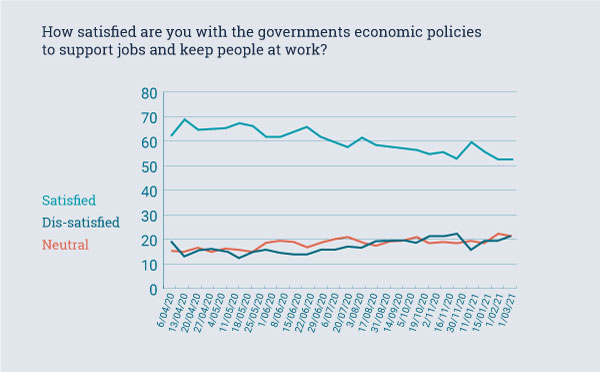About 2 in 3 Australians are willing to be vaccinated and of these, 2 in 3 are willing to wait so those with higher risk get vaccinated first. Of the 1 in 3 who don't want to or are unsure about the COVID-19 vaccination, 65% express concerns about side-effects while 37% express disbelief in the effectiveness and/or distrust of the vaccine. Significant health and economic policy challenges remain in 2021.
The COVID-19 Vaccine
As Australia prepares for the roll-out of the COVID-19 vaccine, concerns have been raised as to the effectiveness of the vaccine in controlling the deadly effects of the pandemic. Much depends on herd immunity – the successful vaccination of a large percentage of the population.

The graph shows that about two in three Australians are willing to have the COVID-19 vaccine and moreover two in three of this group are willing to wait so those at higher risk can get vaccinated first. However one in three, either are not willing to be vaccinated or don't know.
2 in 3 of this group are willing to wait so those at higher risk can get vaccinated first
1 in 3, either are not willing to be vaccinated or don't know. For this latter group, 65% are reluctant because they are worried about side-effects and 37% either don't believe and/or don't trust the vaccine
These results suggest that more public education on the effectiveness of the vaccine might help allay concerns and help improve participation.
How are Australians coping with COVID-19?
Economically, Australia is well on the road to recovery. Official ABS statistics reported that real GDP rebounded strongly by 3.3% in the September quarter of 2020, after falling by a huge 7.0% in the June quarter and a marginal 0.3% in the March quarter. Technically, Australia is no longer in a recession and growth in the December quarter of 2020 is expected to be positive (The official ABS national accounts will be released 3 March 2021). Improvement in activity has also translated to growth in employment and the unemployment rate has fallen from a high of 7.5% in July 2020 to 6.6% in December 2020 while the participation rate has risen from a low 62.6% in May 2020 to 66.2 % in December 2020.

The proportion of people satisfied with government policies to support jobs and keep people at work is currently at 53% which is significantly below the 62% in April 2020. Australia might be on the road to recovery, but significant challenges remain, if growth is to be inclusive.
The proportion reporting financial stress (in terms of paying for essential goods and services) has crept up from 21% at the end of 2020 to 27% in early February. Again there appears to an age effect: 43% of the age-group 25-34 years report being financially stressed compared to 19% in the 55-64 age-group and 8% for the 65+ age-group. Overall, the proportion of Australians vulnerable to adverse income shocks (namely those already financially stressed and those just making ends meet) remain in the majority at 56%.


The above shows that the proportion of Australians reporting that they experience mental distress (experiencing anxiety and/or feeling depressed) some of the time is now at 21% which is about the same as in April when this survey started. In general, the proportion experiencing mental distress little to none of the time remain above 50% (though it has edged down from 57% at the end of 2020 to be 55% in the first week in February). There seems to be an age effect to experiencing mental distress most of the time – 33% of those in the 18-24 age bracket report experiencing mental distress most of the time compared to 9% for the over 65 years old.
© The University of Melbourne – Melbourne Institute: Applied Economic & Social Research, 2021. This work is copyright. The material may be reproduced and distributed for non-commercial purposes only, subject to the inclusion of an acknowledgment of the source(s).